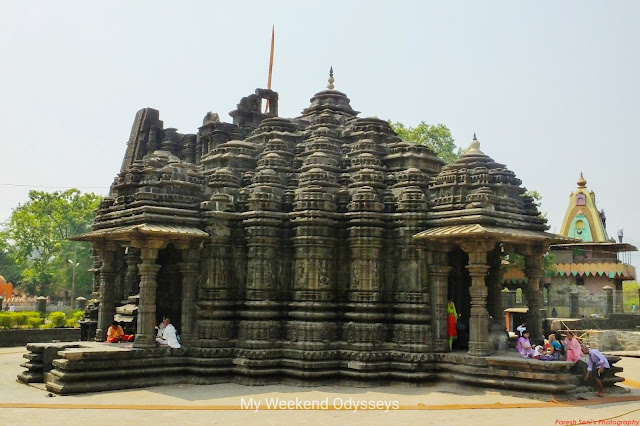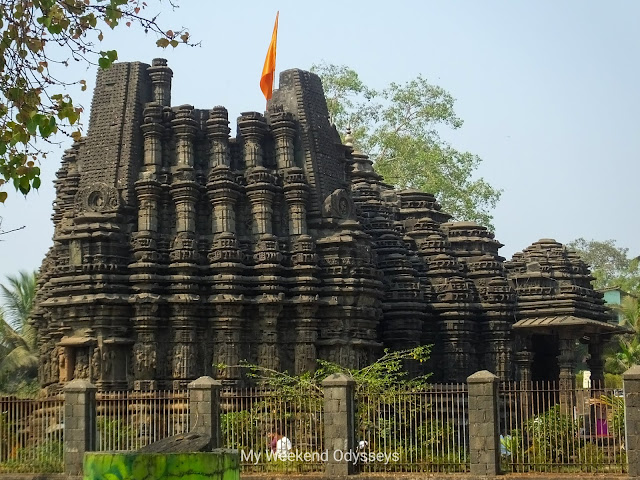The Lord of the Sky (Ambernath) temple - Ambreshwar Shivalaya
Some 60 kms to the east of Mumbai lies a satellite suburb of Ambernath, The name Ambernath literally means The Lord of the Sky. To many it's just a stop on the way to Karjat but some 2 kms from the station on the banks of Vadavan (Waldhuni) river lies a 11th century masterpiece - Ambreshwar Shivalaya.
History: Shivalaya also known locally as "Puratana Shivalaya" is said to be built in 1060 AD by Shilahara King Chhittaraja and completed / rebuilt by his son Mummuni. This is mentioned in the inscription engraved on the northern porch lintel of the temple. Historical records shows that this is the oldest existing temple built in Bhumija style of architecture which is popular in temples of western India, Northern Deccan and Malwa regions of India. If one has to believe in legendary tales than the temple was built by Pandavas from a single mass of stone in one single night.
Local excavations shows that Ambernath was populated as early as 200 BC and was known as "Hallyacha Pada" which was later renamed as Ambernath. It is noted Guru Nanak also visited the temple around 1415.
Temple Architecture: The temple is constructed with black stone and lime, in style typical of 10th century Hemadpanthi temples which is subset of Vesara style, a combo of Nagara style of Northern India and Dravidian architecture of the South. The temple has been often been compared to Dilwara temples of Mount Abu for the quality of architecture and ornamentation seen, Eminent Indologist Stella Kramrisch has drawn parallel between the most beautiful temple of Khajurao - Kendariya Mahadev and Ambernath Shivalaya in her book.
 |
| Sourced from Internet |
Each of three porches on three sides of mandapa has pairs of pillars of 10-12 feet in height each carved with sculptures and ornamentation telling some story or a poetry.
The sanctum sanctorum is subterranean chamber, So one has to descend by climbing down flight of steps. The sanctum holds a two swanyambhu Shiva Ling which is open to the sky as their is no ceiling. The top dome of the temple has been destroyed or disintegrated but the rest of temple seems to be remarkably intact.
What is interesting and a treat to the eyes is the outer wall which houses lot of sculptures which can be rightly identified by the vahanka or the carriers.The temple is held up the layer of about 250 elephants called Gaj Thar which means layers of elephants.
The layers above it houses sculptures of Mithunas and Sura Sundaris. Carvings of sculptures are predominantly Shiva theme although some have been lost to time and also due to soft nature of the stones. There are few very important and unique sculptures among the exterior walls, two most important ones being that of Lord Brahma, an outstanding sculpture of Brahmadeva and a rare one of Hari Hara Pitamaha Surya in which four gods Shiva, Vishnu, Brahma and Surya are portrayed as one deity.
There is also a three faced Shiva in standing pose unlike the one in Elephanta caves where there is only a bust, Shiva is adorned with necklaces, girdle, bracelets and foot ornaments. It also has a jata mukuta.
Another image on the North is that of Mahakali which is unique in the sense that it has thin shrivelled body and dropping breast. A necklace of human skulls hanging to her feet and holding her weapons such as dagger, sword, trishul, Khatonga. She is shown dancing with her limbs bend and serpents twined around her neck and waist. On her two sides are her devotees which are also shown with shrivelled body.
Something unique or mysterious about some of the sculptures is that they are shown with thin, pale and crippled body. I haven't been able to get any details on why this is so ? There are few sculptures of Bhringi, devotee of Shiva holding a stick in its hand like a crippled man.
One can also see few sculptures of hermits, noticeable is their different shapes of beard and hair braid style. One of the hermit seems to be holding "Head of a man" in his hand.
There is also Varaha avatar and Ganesha, Sura sundaris or apsaras in different poses are shown with voluptuous body and wearing heavy ornaments.
Hidden among these sculptures, on closer look one can also find few erotic sculptures though it is not prominently seen.
It is said that owing to its Hemadpanthi origins, the temple was built using male female block of stones and no mortar was used. Over the years the structure has weakened due to which reinforced iron beams have been erected inside to strengthen the structure.The temple stands in a hollow on the banks of nearby river on a high platform called Jagati. The reason could be because of Swayambhu linga in the sanctum sanctorum.
Ambernath Shivalaya is regarded as the earliest and best example of fusion of different style of architecture and it evinces the interest in Shilahara dynasty rulers who were instrumental in constructing magnificent temples of their gods and goddess.
Discovery during British rule: Earliest photograph of temple taken in 1850 by ASI superintendent shows it in dilapidated condition with trees growing from the wall structure. ASI then took detailed documentation of the temple and some conservation work was carried out. Thus the temple that was lost between 1060 to 1850 was rediscovered.
Few romanticized words of a Captain Lyon from 68th regiment of light infantry wrote in 1871
"At Callian (Kalyan) a halt should be made in order to visit a small ruined temple of Ambernath distant about 5 miles, but the road is so exceedingly bad that it will be necessary to arrange before hand to have ponies or horse in waiting at the station, The temple is completely deserted and can be examined without let or hindrance both inside and out, not a Brahmin nor a native being ever to be found near the spot"
Today the temple is well managed under ASI administration even though it is live temple with regular worship and prayers done on daily basis.
How to reach: Temple is located around 2 kms from Ambarnath station east. Regular rickshaws are available or one can also walk down from the station in 20 minutes.
(Excerpts from the book written by Dr Kumud Kanitkar)








































Comments
Post a Comment